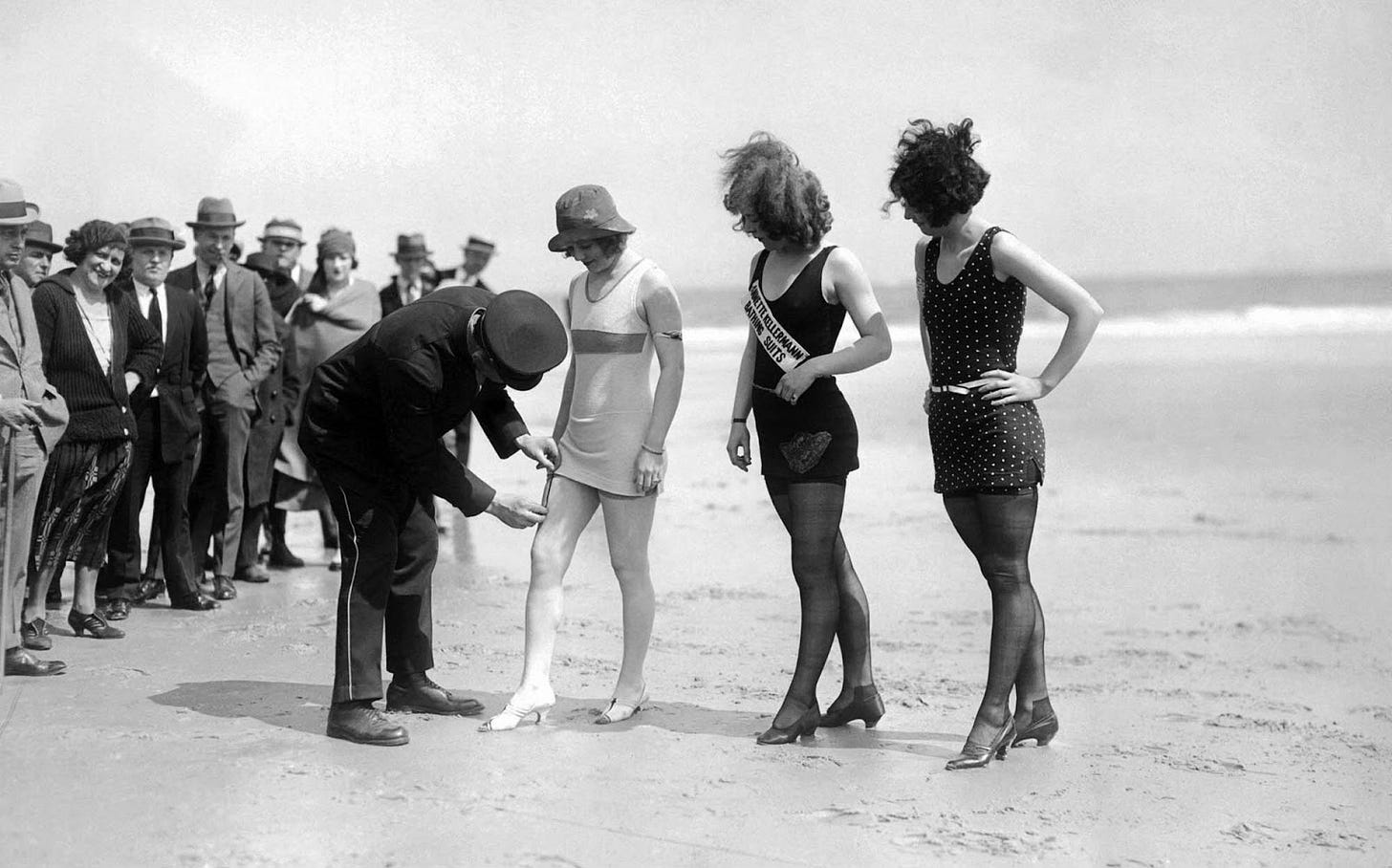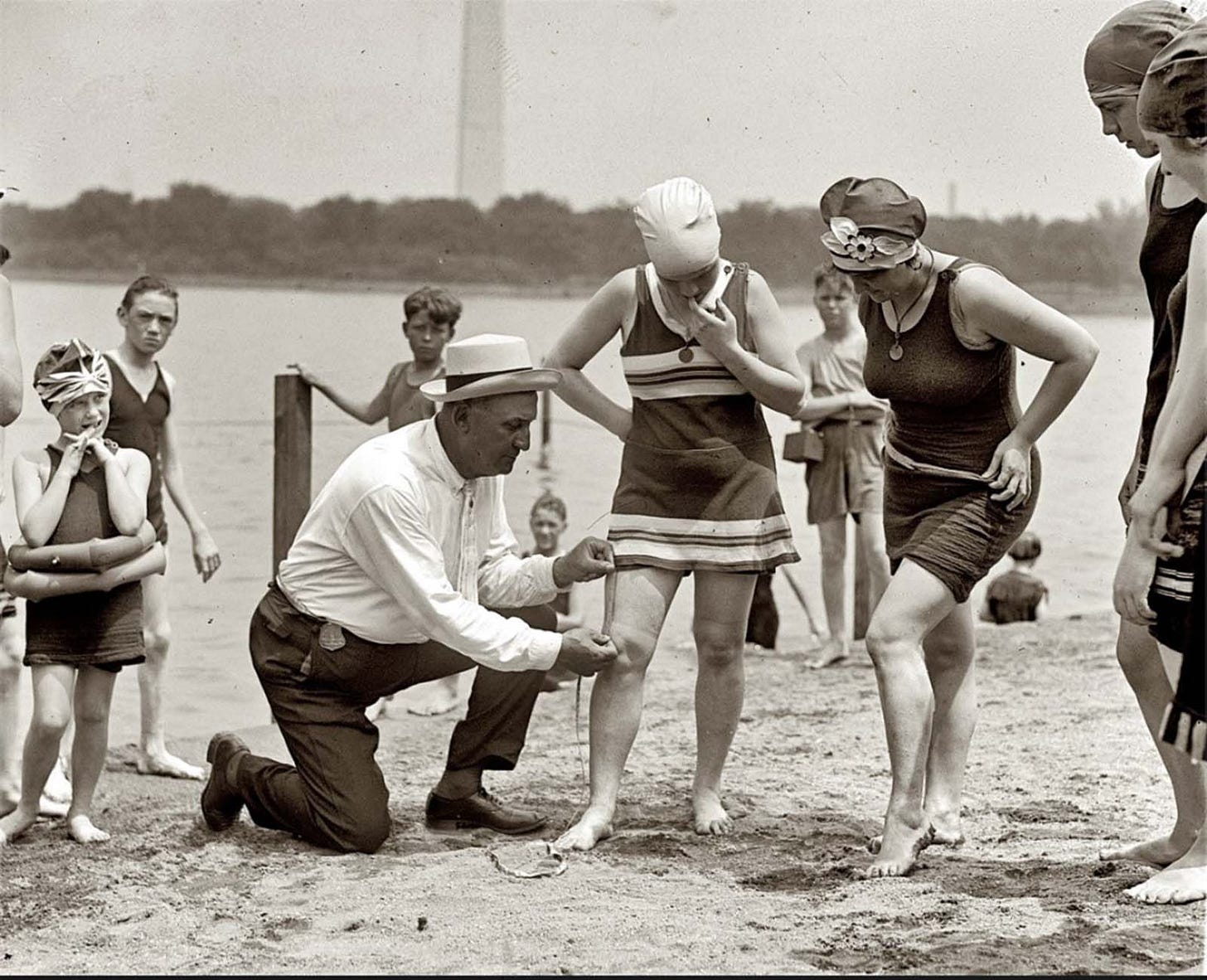Hello Friends!
If you’re new here, welcome to Body Talk! This is our weekly newsletter where we discuss a range of topics related to women’s health, wellness, body image and self esteem. I’m happy you’re here!
We are now back to our regularly scheduled programming and I am so excited to bring you Part I of our new series on Modesty! If you weren’t around a few weeks ago, we began this discussion here, with Anette Kellerman; world renowned women’s swimmer and the story of her public arrest over a one-piece swimsuit.
After writing about Annette and her story, I ran across this article discussing the spark of outrage over Annette’s new suit. I found the photos and stories to be fascinating, considering what much of women’s beach attire looks like today.


It sparked some interesting commentary and it seems this topic is one many of us have wanted to touch on for a while. It’s a topic I know I have carried shame and guilt around as a woman.
What even is Modesty? Why does it matter and why does it seem to only matter for women and not men? Hopefully, we will answer these questions and start an important discussion on how our current views of modesty might affect our body image and self esteem.
This series will unfold in three parts:
What is Modesty and where did this idea come from?
Why is Modesty a woman’s responsibility?
How does Modesty affect Body Image?
Like I always say, we cannot know where we are going if we don’t know how we got here, so today we are going to explore the origins of modesty and what it really means.
So what does Modesty really mean?
The word modesty comes from the Latin term modestus, which means “keeping within measure.” In the feminine form, “Modesta” means; calm, restrained, discreet and/or reserved.
In English culture, the term modesty has evolved to mean a few things:
Self-restraint or humility: Referring to someone who doesn’t boast, act overly proud, or seek excessive attention.
Decency and propriety in behavior and dress: This meaning often implies an expectation, especially for women, to dress and act in ways that do not draw sexual attention or violate social norms.
I don’t think it’s a secret in our modern world that modesty is not usually used as a descriptor for things like behavior or expressions of wealth. It’s used as a descriptor for women’s clothing or how women use clothing to either entice or avert the male gaze.
So, if the meaning of modesty includes the seeking of excessive attention through behavior, where did these two paths converge and the word modesty become exclusively associated with women’s dress?
We will need to travel back in time to ancient Mesopotamia and the Code of Hammurabi to find out.
The Code of Hammurabi was created in ancient Babylonia around 1754 BC. It is one of the oldest and most famous sets of laws from the ancient world. Named after King Hammurabi and created under his rule, the code consists of 282 laws inscribed on a large stone. The laws were intended to govern various aspects of daily life, including, trade, marriage, family relationships, labor and justice.
Within this code, women actually had legal rights. They could own property, engage in business and inherit assets. These types of laws were not isolated to Mesopotamia either. Women enjoyed the freedoms of owning property and engaging in business and trade in the early societies of Egypt, Minoan and Ancient Persia as well.
After the Assyrians conquered Babylonia, they tightened the rules and added the Laws of Veiling for women to the code. Women were separated into two categories and veils were required to be worn to distinguish between them:
Married women, concubines, daughters of free men and priestesses were required to wear the veil to in order to signal their social status, virtue and respectability.
Slaves, prostitutes, and certain other lower-status women were not allowed to wear veils and if they wore the veil, they would face severe punishment.
Veiling became a way to visually distinguish between "respectable" women and “others.” Women who were covered were more respectable than the women who weren't.
The rules didn’t end with the Assyrians.
The laws of Ancient Athens (Greece) took things a step further by reinforcing the concept of women as property of men, stripping them of their former citizenship and right to education. These laws eventually dissolved women’s rights to participate in politics and own property. Women were placed under the authoritative governance of a male (father, husband or in sone cases another male relative) who acted as their legal representative. This all came about because of several factors, which we cannot get into for the sake of time, but the short of it is, this part of the ancient world was developing fast into the system of patriarchy which elevated masculinity, particularly in public and political spheres, while relegating women to the domestic realm.
As we move into the Middle Ages, religion would begin to play a significant role in shaping the ideas of modesty, particularly from the early Middle Ages through the Renaissance.
Note: Modesty is a common theme throughout the Abrahamic religions of Christianity, Judaism and Islam. In this series I will be focusing on the traditions and teachings of Christianity as this is the religion I practice and the one with which I am the most familiar.
In the early days of Christianity, teachings emphasized the importance of chastity as a virtue. The general thought was that when one was dressed modestly, the temptations (particularly those of a sexual nature) were limited or controlled and the virtue of chastity was upheld. “A chaste life was a pure life.” (There is definitely more to be explored and discussed here, but again, for the sake of time I have kept this as concise as possible)
The scriptures would be used frequently to uphold these standards throughout the 17th & 18th centuries, but it wasn’t until the 19th century that the most extreme forms of modesty began to proliferate in society.
The Victorian era - while grand in the way of the Industrial Revolution and the rise of the middle class - was marked by strict moral codes. The idealization of the family unit was paramount, with the modesty of its women seen as essential to maintaining social order. The ideal Victorian woman was expected to be chaste and virtuous with a heavy emphasis on sexual purity in order to maintain the honor of the home and the family. The belief that one must remain a virgin before marriage was deeply ingrained in societal expectations and marriage was viewed as the ultimate goal or the “highest achievement” for a woman.
A Victorian woman’s worth was tied directly to her virginity, her ability to marry well and her ability to bear children. Women were the “moral guardians” of the home, this guardianship included how they dressed. Victorian dresses typically featured high necklines, long sleeves, and full skirts. Layers of undergarments were eventually added, including corsets and petticoats, to achieve the dress most reflective of modesty, but to also ensure a “desirable” shape. (The irony of this is not lost on me) The corset was considered essential for creating the “ideal feminine form”, which was also celebrated in society.
In the middle of the Victorian era, there was a shift in cultural norms as women began to question their place and role in society. Could women be more than wives and mothers? Should they be allowed to vote? Own property and have an overall say in how society is run?
These small seeds of change would grow into what we know today as the feminist movement, beginning with the Women’s Rights Convention in 1848. (Although this is widely considered to be the start of the first wave of feminism, women’s rights were being fought for all the way back to the French Revolution.)
So all throughout history, while women’s clothing was evolving (eventually requiring them to be covered from neck to ankles) to avoid society becoming immoral and unchaste, men were allowed multiple wives, concubines and frequent visits with prostitutes in brothels.
How and why did the responsibility of morality and purity fall completely on the women? Shouldn’t men have some responsibility for upholding the morals of a society as well?
Come back and find out next week in Part II!











